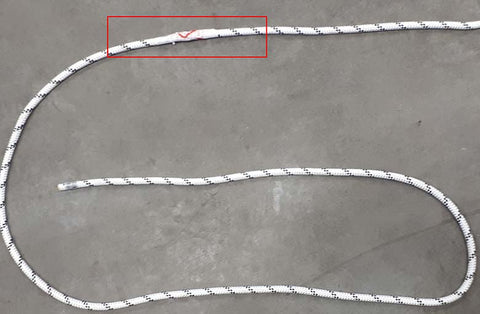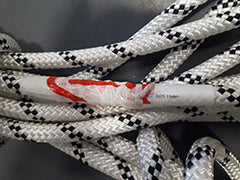
PLEASE INSPECT YOUR PETZL LOW-STRETCH ROPES
One of Petzl’s clients found 2 critical defects on his Petzl low-stretch kernmantle ropes. To date, no other client has reported similar defects to us, and no accident or injury is known. Please read the information below and, if necessary, inspect your ropes.
Request for inspection of Petzl low-stretch kernmantle ropes:
- AXIS 11 mm
- ASAP’AXIS 11 mm
- PARALLEL 10.5 mm
- VECTOR 12.5 mm
- RAY 12 mm
- SEGMENT 8 mm
- CLUB 200 10 mm
- PUSH 200 9 mm
- TOP 9.8 mm
- LEAD 9.8 mm
- KIT including these ropes
With serial numbers between 18 C 0000000 000 and 20 H 0000000 000
While unpacking new Petzl AXIS 11 mm ropes, one of our customers found the following two defects:
- a deep cut in an AXIS 11 mm rope manufactured in June 2019

- a 2.1-meter scrap of rope taped to one end of an AXIS 11 mm rope manufactured in September 2019

To date, no other client has reported similar defects to us, and no accident or injury is known.
Our in-depth investigation and risk analysis have led us to the following conclusions:
- the two defects occurred on one of our rope-cutting machines
- the two defects have common root causes
- the risk of the two defects occurring is near zero (only a complex sequence of multiple, independent factors could lead to the occurrence of the defects)
- this risk did not exist prior to March 2018
- only the ropes cut on this machine are at risk of these defects
We took immediate corrective actions to eliminate this risk on the production line. Our stock is in the process of being inspected and no further defect has yet been found.
As a precaution, we ask that you immediately inspect each of your low-stretch kernmantel ropes listed below that have a serial number between 18 C 0000000 000and 20 H 0000000 000:
- AXIS 11 mm
- ASAP’AXIS 11 mm
- PARALLEL 10.5 mm
- VECTOR 12.5 mm
- RAY 12 mm
- SEGMENT 8 mm
- CLUB 200 10 mm
- PUSH 200 9 mm
- TOP 9.8 mm
- LEAD 9.8 mm
- KIT including these ropes
The inspection must be carried out by hand, without gloves, along the entire length of the rope, and in accordance with the below operating procedure.
If you find any defect, please quarantine your rope immediately and contact us.
The inspection we are asking you to carry out fulfills certain criteria from the detailed periodic inspections you must carry out at least once every 12 months. However, if you encounter any difficulty carrying out the inspection, please contact us.
We are aware of the inconvenience that this inspection request may cause; please accept our apologies. Our customers’ safety remains our top priority, and all of our teams are making every effort to assist you
We thank you in advance for your understanding and are relying on you to immediately report to us any defect found.
Inspection operating procedure
In order to carry out the low-stretch kernmantle rope inspection, we ask that you follow these operating procedures:
- Is your low-stretch kernmantle rope on the list of Petzl ropes affected by this inspection request?
– NO → your rope is not affected by the inspection request
– YES → go to paragraph 2
– I don’t know → as a precaution, go to paragraph 2.
- Identifying the serial number on your rope:
Your rope’s serial number is on the label affixed to each end of the rope, on its Instructions for Use, and on your PPE register.
Example of a serial number: 18 C 01254697 807
– My rope’s serial number is: YY M xxxxxxx xxx → go to paragraph 3
– I can’t find my rope’s serial number → go to paragraph 4
- Is your low-stretch kernmantle rope’s serial number between 18 C 0000000 000 and 20 H 0000000 000?
– YES, the first three characters of the serial number are: 18C, 18D, 18E, 18F, 18G, 18H, 18I, 18J, 18K, 18L, 19A, 19B, 19C, 19D, 19E, 19F, 19G, 19H, 19I, 19J, 19K, 19L, 20A, 20B, 20C, 20D, 20E, 20F, 20G
→ your rope is affected by the inspection request → go to paragraph 4
– NO (example: 18 B 9999999 999) → your rope is not affected by the inspection request
- Is your rope new and never-used?
– NO (it has already been used) → go to paragraph 5
– YES → go to paragraph 6
- Has your rope already been used or inspected in one of the following ways?
– installation of the rope by running your hand along its entire length without gloves
– coiling the entire length of the rope without gloves
– detailed periodic inspection of the rope already carried out
NO, or I’m not sure → go to paragraph 7
YES → you do not need to inspect your rope again, and we ask that you inform us on the registering my rope inspection form
- Is there a green sticker on the box of my new rope?
– NO → it has not already been inspected → go to paragraph 7
– YES → your rope has already been inspected by a professional and you do not need to inspect it again
- Inspecting your rope by hand, without gloves, along its entire length:

Only production defects (1) and (2) below are affected by this inspection request. If you find a defect described in this inspection request, please write down the serial number of the affected rope, immediately quarantine the rope and contact us.

(1) Production defect covered by this inspection request

(2) Production defect covered by this inspection request
- Once your rope has been inspected, we ask that you enter the result on the registering my rope inspection form.
- If you run into problems or difficulties carrying out the rope inspection, please contact us.





